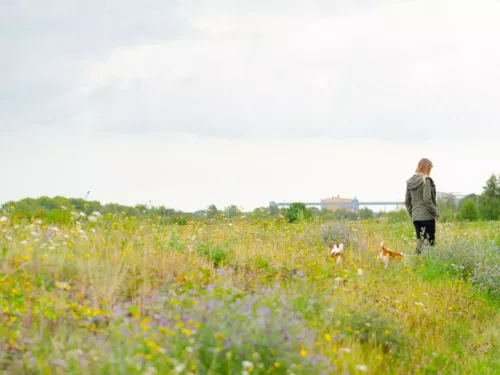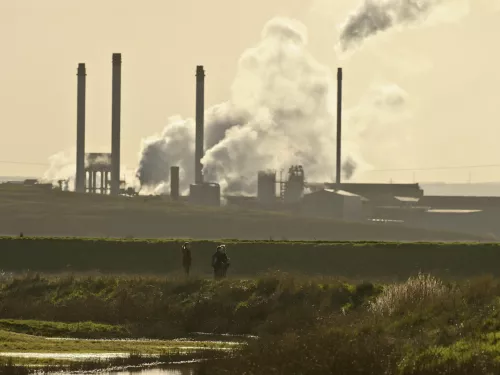
Swanscombe saved - for now. But campaigners stress the fight is not over
Plans to build a theme park on top of 100 hectares of a nationally important wildlife site have been withdrawn at the eleventh hour.

The Lower Thames Crossing is a proposed new road which will connect Kent with Essex by tunnelling beneath the River Thames estuary. Kent Wildlife Trust is opposed to these plans as they will result in the loss of irreplaceable ancient woodland.
On Thursday 9th March 2023 the government announced that, even if planning were to be approved, the construction of the Lower Thames Crossing will be delayed by two years.
Despite this news, our concerns over the environmental impacts of the Lower Thames Crossing remain the same.
The Lower Thames Crossing, if built, will result in the loss of irreplaceable ancient woodland habitat, and increase pollution levels.
A delay in the process illustrates our concerns and therefore we would want to see alternative transport options.
The Lower Thames Crossing is a proposed new road which will connect Kent with Essex by tunnelling beneath the River Thames estuary. The proposal requires the creation of 14.3 miles of new road as well as widening existing roads including the A2 and M2 in Kent. Kent Wildlife Trust is opposed to these plans as they will result in the loss of irreplaceable ancient woodland.
We remain opposed to a crossing east of Gravesend and have raised serious concerns during about environmental damage during public consultations, the latest of which closed on the 12th August 2020. Working with other conservation organisations, we have managed to successfully influence the Highways England to greatly reduce the impacts of the scheme through design changes. These changes include securing a tunnel underneath the River Thames, in place of other crossing types, thereby greatly reducing impacts upon the internationally important habitats of the North Kent Marshes and Thames Estuary. The tunnel entrance in Kent was not without its threats to wildlife, and to reduce these threats we worked with other organisations to extend the length of the tunnel so that it surfaces further from protected wildlife sites. Despite this huge effort from across the conservation sector, threats to wildlife still remain and are unlikely to ever be fully overcome.
Highways England are expected to submit their application to the Planning Inspector at the end of October 2020, at which point Kent Wildlife Trust will formally object to the proposal with the aim of influencing the planning inspector to refuse the scheme.
The decision-making process is flawed. While the economic benefits of this scheme have been weighed against the financial costs, they have not assessed the economic costs that arise from damage to the environment and communities.
We believe that the only sustainable way to reduce congestion is to reduce demand. This has the additional benefit of reducing air pollution and the greenhouse gasses that result in climate change. Air pollution is the leading environmental health risk factor in the UK, and climate change is one of the greatest threats to our environment and the ‘ecosystem services’ which we depend upon. We believe that road developments should only be considered as a last resort within a sustainable transport strategy, which must be planned and fully integrated with conservation objectives and the land use planning process. This should:
The link road will destroy parts of Shorne & Ashenbank Woods SSSI. The SSSI includes both Shorne Woods Country Park and the Woodland Trust’s Ashenbank Woods on the south side of the A2.
The site supports an important and diverse invertebrate fauna, especially beetles, true bugs and dragonflies. The woodland varies from sweet chestnut coppice to a more mixed broadleaved woodland of mature oak, sweet chestnut, and hornbeam, and holly and yew are frequent in the understorey. Bramble, bluebell, dog’s mercury, and bracken dominate the ground flora, together with ancient woodland indicators such as wood spurge, wood sedge and wood anemone. The woodland breeding bird community includes hawfinch, marsh tit and all three British woodpeckers. Despite the national protection of this site the Lower Thames Crossing is not properly accounting for its importance.
Proposals such as this, which result in the loss of SSSI, are almost unheard of within the local planning system. There is a serious risk that these Nationally Significant Infrastructure Projects (NSIPs) will erode our precious wildlife if we do not speak up. Unlike most planning applications, NSIPs do not follow the conventional planning application route, instead, follow a “fast-tracked” process where the deciding decision is made by the Planning Inspectorate on behalf of the Secretary of State. This means that requirements of planning policy, which require applicants to deliver biodiversity net gain to not apply and there are regular arguments that the benefits of the scheme outweigh the loss of irreplaceable habitats such as ancient woodland. We argue that NSIPs should be bound to the same rules as everyone else.
The link road will destroy parts of Shorne & Ashenbank Woods SSSI, including ancient woodland at Brewers Wood and Brices Plantation, and Claylane Woods. Ancient woodland is one which has been present since 1600, and are often best identified by the suite of ‘indicator species’ that they support. Ancient woodlands now only cover about 2% of the country and are irreplaceable.
We are calling on Highways England to avoid the loss of any ancient woodland or at the very minimum to provide 30 hectares of compensation for every one hectare of ancient woodland lost. At the last consultation in August 2020 compensation proposed was for a mere six hectares for every one lost.

Plans to build a theme park on top of 100 hectares of a nationally important wildlife site have been withdrawn at the eleventh hour.

The UK Government has launched an attack on nature, weakening the laws that protect our wildlife and making a U-turn on manifesto promises to be the greenest Government ever.

Kent Wildlife Trust is working to raise awareness of the issues affecting wildlife. Check out our campaign page to see what we're currently working on and how you can get involved!